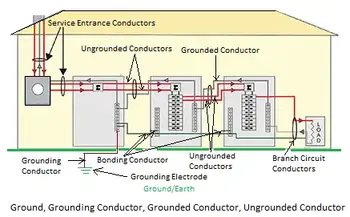Grounding and Bonding - How To Improve Your NEC/CSA Installations

Grounding and Bonding are the least understood, the most misinterpreted and confusing elements in modern electrical and electronic systems and leads to poor design and installation work — especially as it relates to the Canadian Electrical Code (CEC) and to the National Electrical Code (NEC) requirements.
Misinterpretation of the rules causes their misapplication and consequently improper installation of critical systems such as “Telecommunications”, “Instrumentation & Control, “Lightning Protection Systems’ and protections against “Electrostatic Discharges”. The overall result ends up in Power Quality problems, electric shock risks and catastrophic damages such as fires and explosions in some industries such as the Petrochemical Industry, hazardous military installations where weapon systems are stored and improper grounding during aircraft refueling.
Metal parts are grounded to the earth to help prevent build-up of high voltage static charges where the discharge (arcing) could cause failure of electronic equipment.
It is important to note that electrical codes only provide the “minimum requirements for personnel safety” and for the industrial world we must go beyond the code to ensure the proper design, installation, maintenance and operation of equipment. Industry standards such as “IEEE standard 1100” (Emerald Book) “Recommended Practice for Powering and Grounding Sensitive Electronic Equipment” and “IEEE standard 142” (Green Book) “Recommended Practice for Grounding of Industrial and Commercial Power Systems” and others such as NFPA and military standards provide recommendations for particular environments.
Improper terminology and definitions not authorized by the electrical code and industry standards causes confusion and misunderstandings. Lack of understanding of the differences between, important terms such as "bond, bonded, bonding, ground, grounded, grounding, and effectively grounded," and their intended application are often misunderstood, or worst yet, they are improperly used.
Another important lack of understanding of the differences between “ground resistance”, “ground impedance “, “resistance- to -ground”, and “ground resistivity” are very often misunderstood and improperly used.
When grounding and bonding is implemented correctly it can help the facility during its normal operations and during some type of power disturbances such as a lightning strike, transient over voltages, power surge and even voltage fluctuations. Proper grounding also protects electronic systems from “electromagnetic interferences’ (EMI), “radiofrequency interferences” (RFI) and “electrostatic discharge” (ESD).
It is important to clarify many misconceptions about bonding and grounding and break down CEC Section 10 and NEC Article 250. It will clear up confusing or seemingly conflicting NEC and CEC rules and give tips on proper installations, cautions, and warnings of dangers related to improper installations.
Technical requirements of the Canadian Electrical Code are very similar to those of the U.S National Electrical Code and installations acceptable under one Code may not entirely comply with the other but correlation of technical requirements between the two Codes is ongoing.
There is also the need to eliminate some of myths that cloud this subject and give a better understanding by clearing up misconceptions, lift some of the veils of mystics and simplify code requirements for acceptable field installations of grounding. Grounding obeys the laws of electricity, and when examining piece-by-piece and conductor-by- conductor, all elements fit together to form an effective grounding system.
In the construction industry, the first step when erecting a building is to prepare the ground for the building to set on. The ground supports the weight of the building. Unless the building is set firmly on the ground, it may have continuing structural and electrical problems. The grounding electrode must be properly installed in the ground, and all the grounding paths must be directed to it. The grounding system must be effectively connected to the grounding electrode.
Grounding is the reference zero and the foundation of the of the electrical system.
Electrical grounding starts with the discussion of the ground and the grounding electrode, because the grounding electrode supports the entire grounding system, and all grounding paths lead to the grounding electrode.
The first rule is to make it safe; the second is to make it work.
On-Site Training
Interested in cost effective, professional on-site electrical training?
We can present an Electrical Training Course to your electrical engineering and maintenance staff, on your premises, tailored to your specific equipment and requirements. Click on the link below to request a Free quotation.
EF PARTNER MEDIA
Product Showcases
Shared Media
















